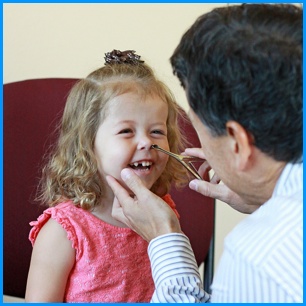In this section we discuss common conditions that impact the nose and sinus:
- Nose Bleeds
- Nasal Foreign Body
- Nasal Fracture
Nose Bleeds

Nosebleeds, or epistaxis, occur when blood vessels along the center portion of the nasal passage (the septum) are exposed and begin to bleed. Common causes of nosebleeds include:
- Allergic rhinitis
- Nose picking
- Use of nasal steroids
- Nasal foreign bodies
- Exposure to dry and warm air, particularly at night
- Vigorous nose blowing
- Crooked (deviated) septum
Many children with nosebleeds have relief with use of nasal saline gels or gel sprays, or other ointments such as Aquaphor. Nighttime cool mist humidification is beneficial to children with nighttime nosebleeds. Cessation of nasal steroids, or changing the direction of the spray away from the septum helps in those using nasal steroids. There are children that continue to have nosebleeds and benefit from cauterization.
Nasal Foreign Body
Nasal foreign bodies can be found at any ages, but more commonly in younger children, who are exploring their environment and picking up items. Common items include food, beads and small toys. Most are located in the front of the nose. At times, the foreign body placement is not witnessed, and it is unknown that the child has a nasal foreign body. Children who have a nasal foreign body often exhibit the following:
- One sided (unilateral) drainage, typically colored, and at times can be bloody
- Nasal blockage/obstruction, particularly one sided
One particular nasal foreign body that is considered an emergency is a disc battery. They are found in many small toys and some children’s books that have music or sound. When the battery is exposed to the nasal tissue, the contents “leech out” of the battery, causing a chemical reaction resulting quickly into tissue damage.
Nasal Fracture
A nasal fracture is a crack or break of the bone of a child’s nose on the bridge of the nose.
Nasal fractures commonly occur in children due to either falls or being struck in the face. A child who has a broken nose may exhibit the following symptoms:
- Swelling of the nose or face
- Bruising on the nose
- Bruising under the eyes
- Crooked nose
- Nosebleeds
- Nose is tender to the touch
- Difficulty breathing out of the nostrils

There are instances when the fracture is very mild or “non displaced” (there is a break, but no separation), and may not require any treatment. If the nose is considered “crooked” and the bones are displaced, your child may benefit from surgical reduction of the nasal fracture.
